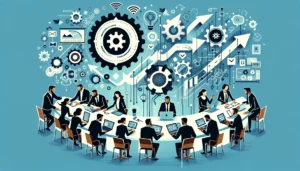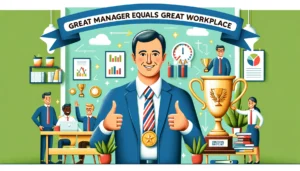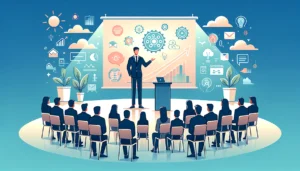Future of work: How female leaders are transforming the workplace
- 7 Min Read
Female business leaders have embraced the new normal and are shaping the future of work, says Annie Thompson, VP of strategic partnerships, Velocity Global
- Author: Annie Thompson
- Date published: Jun 16, 2021
- Categories

Remote work is the new normal, changing everything from the way teams interact to how managers keep employees productive and happy. At the same time, companies are adopting new attitudes to the work-life balance, gender representation in the workplace, and how best to empower the next generation of leaders.
These changes bring huge opportunities for improving the way we all work – and female business leaders are taking the reins. In a recent webinar with three executives from across the globe, we discussed how women are shaping the future of work. My guests included:
- Mei Burgin, lead executive of Startup Programs at MaRS Discovery District. Based in Toronto, MaRS is North America’s largest innovation hub. The not-for-profit incubator offers expert counsel and resources to thousands of Canadian tech companies.
- Gayle Davies, partner and FDI specialist at RSM UK. Davies has 24 years of experience working for RSM, a leading UK audit and tax consultancy firm. She currently partners with RSM’s North American tech clients navigating international expansion.
- Sarah Grimstead, regional vice president at Insperity. Insperity streamlines HR operations for more than 100,000 businesses across the US. Grimstead has spent 22 years helping clients improve how they manage and care for their employees.
These women bring decades of combined expertise in everything from blockchain and cloud technology to maximizing ROI for companies moving into new markets. While their specific skill sets differ, they all have a proven track record in leadership roles at the world’s most innovative and successful companies. More importantly, they all have invaluable firsthand perspectives on what it takes to overcome the unique challenges facing women in the workplace.
Outlined below are three key takeaways from our discussion on how female leaders are changing the way we work:
Female leaders set new standards for employee care
Employees develop new needs when they move from the physical office to remote work. Female managers are stepping up to give their teams the support necessary to thrive amidst the transition.
Leaders who work alongside their teams in the office have an easier time assessing and understanding the needs of their team members, according to Davies
“You can pick up on nuances, you can see how people are thinking or feeling, you can see if someone is stressing a bit. Working remotely, you can’t see any of that.”
Still, remote employees require the same leadership and care they receive while working in the office. Female leaders “tend to be very empathetic,” says Burgin, giving them a better ability to understand their employees – even when they are not in the same physical place.
As a result, women in management positions are changing the way leaders help remote employees feel engaged and productive. For example, recurring virtual team meetings may be helpful for certain team members. But some employees need more one-on-one attention, while others feel overwhelmed by constant Zoom calls and Slack messages.
Female leaders like Grimstead understand the importance of going beyond one-size-fits-all solutions and tailoring communication methods to each employee.
“Everyone needs something different from you as a leader,” says Grimstead. “The sooner you can figure that out and give that to them, the better their experience is going to be.”
While each remote employee’s unique needs differ, manager goals largely remain the same: provide employees with the right mix of clear instructions, constructive feedback, recognition of their success, and overall appreciation for their contributions. Grimstead is part of a wave of female leaders who set new standards for delivering on these goals while teams work remotely.
Female business leaders redefine work-life balance
Just as female leaders must find new ways to communicate with their remote employees, they must also take time to care for themselves. Women who succeed in the age of remote work must reset expectations about their work-life balance.
“We put a lot of pressure on ourselves to become great leaders in work and great parents,” says Burgin. “We feel all the emotions and anxieties that our colleagues and our families are feeling as well. Having that weight and pressure at all times is quite overwhelming.”
The increased responsibility of being a female leader exacerbates existing remote work challenges. A recent survey by Flexjobs and Mental Health America revealed that 75 percent of remote employees feel pressure to answer emails or calls immediately, and 60 percent feel “stuck” to their computers. At the same time, working longer hours is proven to decrease productivity.
Female leaders prevent burnout by sharpening their focus on their own needs. “It’s okay not to work 24 hours a day,” says Burgin. “We need to set aside time for ourselves and to preserve our energy.”
Women balancing multiple caretaker roles also renegotiate expectations at home and work.
“It’s important to be a strong team at home with my husband,” says Davies. “We’ve learned it’s not all on the woman or the mom – we need to share responsibilities.”
Grimstead also stresses the importance of setting boundaries about availability with co-workers and direct reports, so women don’t feel pressured to be on call at all hours of the day. Women leaders who set realistic expectations at home and work not only avoid burnout, they empower other women at every step of the corporate structure.
“This is going to be a very positive outcome, especially for women in the workplace who have gained more flexibility than we ever had in the past,” says Grimstead.
Companies must empower the next generation of women
While female leaders like Grimstead, Burgin, and Davies have all worked their way to the top, there is still a significant gender disparity in senior leadership roles across the corporate world. Increasing female representation in the C-suite requires an active approach from today’s female leaders and their companies as a whole.
Burgin talked about Canada’s tech industry to illustrate the gender gap in today’s business world. Statistics bear out her point: a recent survey by SaaS company Humi reveals that Canadian companies with women in the C-suite employ an average of 47 percent females across their workforces. In comparison, companies with male-dominated C-suites average only 37 percent female representation in their workforces.
This discrepancy will perpetuate itself unless it is actively addressed. That’s because companies that hire fewer female employees give themselves fewer opportunities to develop the next generation of female leaders.
“We need to create a pipeline of early- to mid-career women who can succeed the current generation of female leaders,” says Burgin. “We need to support women early in their careers.”
Current female executives play a significant role in mentoring younger women in the workforce. But companies also need to put systems in place to develop female talent. “We can’t wait another decade for this change to happen organically,” says Grimstead. “There needs to be a specific and targeted plan from leadership.”
Companies that implement female-specific training programs help women develop skills and confidence early in their careers, putting them on track to take on leadership roles down the road. By increasing the number of women at the top, these companies position themselves to improve gender representation across their entire organization and the business world overall.
Shaping the future of work starts here
It’s an exciting time to be a female executive. Changing norms bring new challenges to the global business world, but they also create the potential for bettering the way people work.
Improvements we make today will have an outsized effect on the workplace tomorrow—not just for women, but for the entire working world.
Learn more about how women are shaping the future of work by watching the full webinar here.








